Gibbaeum
Gibbaeum (Haw.) N.E.Br.
Family: Mesembryanthemaceae
Common names: mimicry plants (Eng.); volstruistone (ostrich toes), duimpie-snuif (thumb snuff), papegaaibek (parrot beak), vinger-en-duim (finger and thumb), visbekvygie (fishmouth vygie) and volstruiswater (ostrich water) (Afr.)
Introduction
Gibbaeums are bizarre succulents that grow hidden amongst pebbles; the entire genus is endemic to the Cape Floristic Region, occurring only in the arid habitats of the Little Karoo and surrounds.
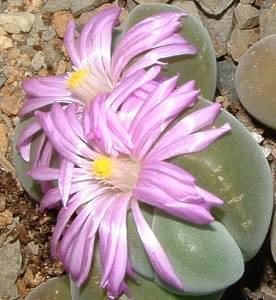
Description
Description
Gibbaeums are small succulent plants that grow close to the ground (never higher than 200 mm), they can have short lateral stems and some species form clumps. The leaves occur at the end of branches in pairs, are thick and rounded and are unequal in shape, a feature that makes this genus different from a similar-looking vygie genus Argyroderma which has perfectly equal-sized leaves and occurs in the Knersvlakte.
The leaves of Gibbaeum often look velvety, as many species have tiny hairs covering the leaves. The flowers are solitary and are always pink, white or mauve but never yellow, which is the colour of many other vygies from the Little Karoo. They flower from around July to November in response to rain. The flowers open in the afternoon and close in the evening. The fruit are dry capsules that have 6 to 9 segments. Many small, rounded seeds are found in each segment.
It is not known how long different individuals survive but these plants may survive for more then 20 years in the wild.
Conservation Status
Status
There are 17 species in this genus, of which 11 have been listed as threatened with extinction in the Red List of South African plants (Raimondo et al. in prep.), meaning that the species are either listed as Vulnerable, Endangered or Critically Endangered. The reason why 65 % of species are threatened is that many species in the genus have very small distributions and are called range-restricted species, which have a total distribution of less than 500 km². Eight species of Gibbaeum occur in an area of less than 20 km². Gibbaeum is therefore one of the top five genera in South Africa with the highest proportion of restricted species.
The tiny range size of many Gibbaeum species make them very vulnerable to any land use that occurs within their distribution. The majority are found in the Little Karoo and are threatened by loss of their habitat to vineyard farming. Even more serious is the ongoing degradation of their habitat from livestock grazing and trampling. As gibbaeums are slow-growing succulents, they are very vulnerable to disturbance by trampling; they are also eaten by ostriches, which is the reason for one of their common names being volstruiswater (ostrich water). Some species are also threatened by illegal collection for the specialist succulent horticultural trade.
Distribution and habitat
Distribution description
Most species within the genus Gibbaeum are restricted to growing in the Little Karoo, some occur in the Overberg and on the Riversdale Plain. They typically occur in stony areas favouring quartz patches, where their pale, velvety leaves are often well camouflaged and it may be difficult to tell them apart from the quartz pebbles. They occur in arid areas receiving winter rainfall (June - October) of between 100 and 700 mm per year.
Derivation of name and historical aspects
History
The genus name Gibbaeum comes from the Latin word, gibba, which means hump. It refers to the thick lumpy shape of the leaves.
Ecology
Ecology
Gibbaeums are well adapted to arid areas; many of the species grow in quartz gravel patches where the plants benefit from the reflection of the sun's heat from the white pebbles. Also, many species have hairs on the leaves which help reflect the sun and minimize water loss from the leaves. This feature along with their ability to store moisture in their succulent leaves means that gibbaeums can often survive many months without any rain. The fruit capsules only open when it rains and the seeds are dispersed by rain droplets - this ensures that they will only germinate after there has been precipitation and the soil is moist.
Uses
Use
A few species of Gibbaeum are grown for horticulture, popular species in the horticultural trade being G. velutinus, G. pachypodium, G. heathiiand G. dispar.
Growing Gibbaeum
Grow
Gibbaeums grow easily either from seed or from cuttings, and are ideal container plants. They also grow well in rockeries. They form very attractive clumps and are highly attractive when in flower. However, they are sensitive to overwatering, resulting in split leaves.
Species
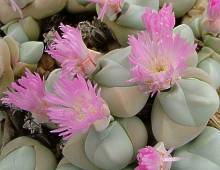
Gibbaeum album is a striking plant with leaves that are almost white and angular, mimicking the quartz pebbles in which it grows, forming compact clumps, 120 mm wide. Flowers have pink or white petals. This species is very restricted, occurring on the northern slopes of the Langeberg Mountains in an area smaller than 5 km².
Red List status: Critically Endangered, as it is threatened by road building, illegal harvesting for the specialist succulent horticulture trade and livestock trampling.
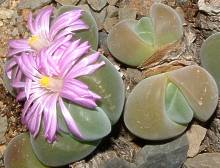
Gibbaeum dispar is a tiny plant up to 20 mm high. In cultivation or in favourable sites in the wild, plants may grow into clumps that are 120 mm wide. Each plant consists of short, woody stems with two unequal leaves at their ends. Leaves are velvety to the touch as they have minute hairs covering them. Flowers are solitary and an intense pink.
Red List status: Vulnerable, as it is restricted to a small area of the Little Karoo near Vanwyksdorp. It is potentially threatened by crop cultivation, mining, roadworks, harvesting for the specialist succulent horticulture trade, and livestock grazing and trampling.
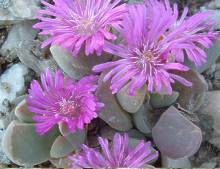
Gibbaeum haaglenii is a low-tufted plant with pairs of leaves that are unequal in size. Old leaf pairs remain on the plant, pressing the growing stems outwards. Leaves are bluish grey-green and flowers are solitary with pink to lilac petals.
Red List status: Endangered, as it occurs only in the Lower Breede River Valley - on small quartz patches. Much of its habitat has been lost to wheat cultivation and remaining populations that occur on fragments between wheat fields are declining due to grazing and trampling by cattle and ostriches.
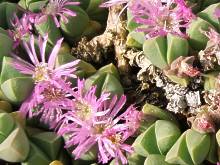
Gibbaeum petrense has sharp-edged, grey-green leaves, forming clumps of various sizes, between 50 and 100 mm wide and 20 to 50 mm tall. Its purple flowers are solitary. It occurs on the northern slopes of the Langeberg, growing in white quartz patches overlaying clay slopes. Its distribution is less than 10 km². In the past, it has lost habitat to road construction and is currently declining due to livestock trampling.
Red List status: Vulnerable.

Gibbaeum pilosulum has rounded leaf pairs that grow embedded in the soil. Each leaf is tiny with a diameter of not more than 10 mm. Leaves are soft and fleshy and are covered in long white hairs. The flowers are solitary and are bright pink. It occurs near Touwsberg where it is declining due to trampling and grazing by livestock.
Red List status: Vulnerable.

Gibbaeum schwantesii forms compact clumps, its boat-shaped leaf pairs are very unequal in size, the larger leaf being between 50 and 70 mm. The smaller leaf is only half the size of the larger leaf. Leaves are green to yellowish green and turn red at the edges. Flowers are typically white. This species occurs on the slopes of Langeberg in loamy renosterveld soils. It is known from two populations that occur within 1 km of each other. It is potentially threatened by soil erosion and trampling by livestock.
Red List status: Vulnerable.
References
- Hartmann, H.E.K. 2001. Illustrated handbook of succulent plants: Aizoaceae Fâe"Z. Springer-Verlag, Berlin, Heidelberg, Germany.
- Nel, G.C. 1953. The Gibbaeum handbook. Blandford Press, London
- Raimondo, D., Von Staden, L., Foden, W., Victor, J.E., Helme, N.A., Turner, R.C., Kamundi, D.A. & Manyama, P.A. (eds). in press. Red List of South African plants. Strelitzia. South African National Biodiversity Institute, Pretoria.
- Smith, G.F., Chesselet, P., Van Jaarsvled, E.J., Hartmann, H., Hammer S., Van Wyk, B., Burgoyne, P., Klak, C., & Kurzweil, H. 1998. Mesembs of the world, an illustrated guide to a remarkable succulent group. Briza Publications, Pretoria.
Credits
Domitilla Raimondo
Threatened Species Programme
June 2009
Plant Attributes:
Plant Type: Succulent
SA Distribution:
Soil type:
Flowering season:
PH:
Flower colour:
Aspect:
Gardening skill:
Special Features:
Horticultural zones






Rate this article
Article well written and informative
Rate this plant
Is this an interesting plant?
Login to add your Comment
Back to topNot registered yet? Click here to register.